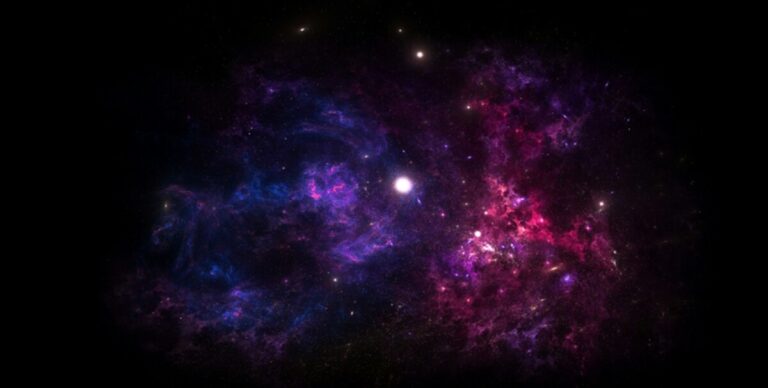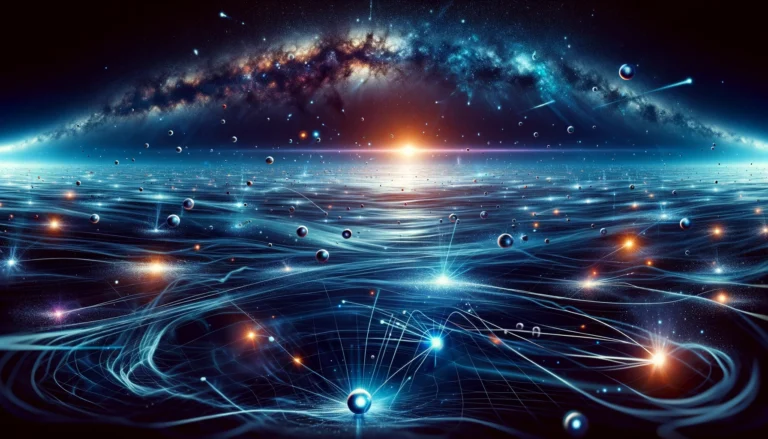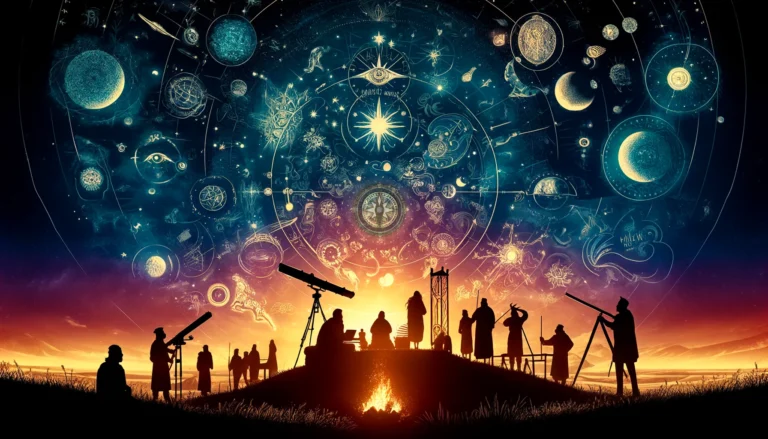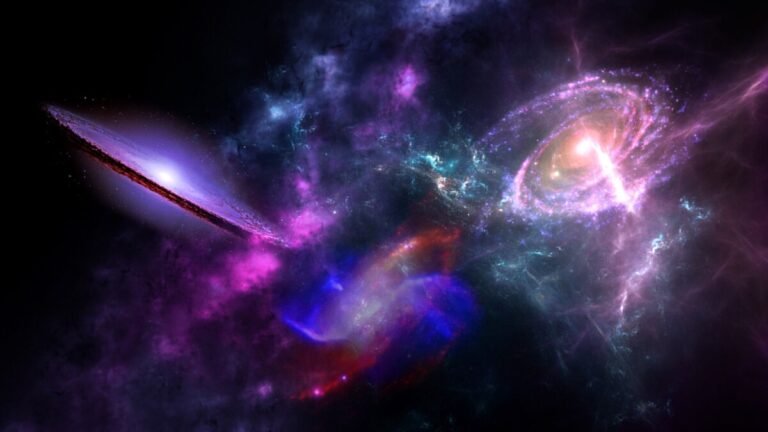Are you ready to step out beyond the known, and perhaps beyond the unknowable? It’s time to speculate about the end of the universe. For an overview of our more concrete ideas about the universe, read my article, The Expanding Universe Explained. That article explores our observations and the best interpretations of them. In the terms of my Idea of Ideas, it explores our rational ideas about our empirical observations.
For a visual insight into the distant future, check out The Future Timeline. For now, let me paint you a picture. Let’s leave solid ground and explore a few irrational ideas, the speculative ones.
Embark on a journey to the very edges of cosmic understanding, where the fabric of reality stretches into the realms of speculation and wonder. Here, we explore the grand tapestry of theories that attempt to unveil the ultimate destiny of the universe. The Lambda Cold Dark Matter (ΛCDM) model is our leading theory. While the Lambda model is our current best guess, at its core, it is still a guess. This article explains why and explores two other ideas: the Big Rip and the Big Crunch. It then introduces a new look: The Islands-of-Universes.

Weekly Wisdom Builder
Got 4 minutes a week?
A new 4-minute thought-provoking session lands here every Sunday at 3PM, emailed on Mondays, and shared throughout the week.
Exactly what the world needs RIGHT NOW!
First, let’s set up this question properly.
The Lambda model is our best guess for explaining the universe’s structure, acting as the cosmic playbook for how galaxies and larger structures form. It is the leading candidate in a cosmic beauty pageant; it ticks most of the boxes by matching up with a lot of what we see through our telescopes, like the cosmic microwave background and the distribution of galaxies. It’s the theory that gets us nodding and saying, “Yeah, that makes sense,” because it fits so snugly with our observations. But why isn’t it crowned as the undisputed champ? Well, because science thrives on skepticism. While it is persuasive, it’s not without its mysteries. Dark matter and dark energy are colossal parts of the theory, and since we’re still grappling to understand them, the Lambda model remains “partially verified,” rather than “unquestionably established.”
Right now, with the galactic material we can observe, the Lambda model puts us on a path to a “Big Freeze,” also known as the “Heat Death.” This is a depressing thought, but you have to remember it still falls in the category of speculation. While parts of the Lambda model are validated, it is also clear we are in the early years of forming an established theory about the end of the universe. To make this point clearly, we are still in the process of trying to identify what we don’t know. While the Big Freeze lines up with our observations, there could be unknown factors or phenomena that alter its course. After all, we are dealing with two scales that are nearly impossible for humans to grapple with: the expanse of billions of light-years and the passing of trillions of years.
Human Cognition
With that setup, let’s add the human mind to the discussion. Time is a fascinating thing. A construct we use daily and throughout our lives that we can barely comprehend. In this article, we’re talking about the end of the universe—something that is so far into the future it’s very unlikely anything resembling Homo sapiens today will exist anywhere in the universe.
Think about a decade of your life—that’s a very long time, but it does come and go. A hundred years is more than a lifetime and at a human level, a millennium is nearly eternity. Homo sapiens emerged about 315 millennia ago and we’ve been trying to comprehend the end of time ever since.
This reminds me of the Hindu Kalpa story, a tale about a raven and a scarf that might go back as far as 1500 BCE. This story serves as a metaphor for the immense, almost incomprehensible scale of time in Hindu cosmology. It’s a tale used to humanize the vast length of time left in the universe compared to how humans experience it.

In this ancient story, it is said that a raven, carrying a delicate silk scarf in its beak, flies across the universe. Every hundred years, the raven gently brushes the scarf against the peak of a great mountain. The time it takes for the mountain to be completely worn away by this light touch is but a mere moment in the grand scale of cosmic time, a duration known as a Kalpa.
A Kalpa is an immense period that signifies one day (including night) in the life of Brahma, the creator god. In modern times, some Hindu scholars believe a Kalpa represents approximately 4.32 billion human years. This metaphor of the raven and the scarf beautifully conveys the nearly incomprehensible length of these cosmic cycles, emphasizing the transient nature of the material world and the eternal nature of the universe. Interestingly enough, it pretty accurately reflects the time duration most modern physicists embrace—a time so vast we speak about it in terms of trillions of trillions of years and in googol years.

Time, Distance, and Speculation
 Part of being human is seeking truth. When we seek truth, we find the knowable and then speculate about the rest. We make empirical observations and then come up with rational ideas about them. Sometimes we think up a rational idea, and then go out and make empirical observations, and sometimes we reverse it. There have been many times great minds have thought an idea and then went out and looked at nature to confirm or disprove it.
Part of being human is seeking truth. When we seek truth, we find the knowable and then speculate about the rest. We make empirical observations and then come up with rational ideas about them. Sometimes we think up a rational idea, and then go out and make empirical observations, and sometimes we reverse it. There have been many times great minds have thought an idea and then went out and looked at nature to confirm or disprove it.
The nature of speculation, which fuels our future endeavors, oscillates between the currently unknown and the unknowable. With the unknown, we will eventually figure it out. The unknowable represents what we can never figure out, though distinguishing it from the merely unknown is often challenging. This is how religions are born, and scientists are susceptible to this process too. While there is strong evidence for the Big Bang, parts of it are still being defined, meaning parts of it are pure speculation. We explore the unknown, what I call irrational ideas, in hopes of learning something rational about the empirical world. While nothing so far contradicts the Big Bang theory, the end of the universe remains speculative.
The farthest human-detected phenomenon is the Cosmic Microwave Background, or CMB. We “see” the CMB in the microwave band of light. Current estimates, based on observable redshift, place the CMB about 46.5 billion light-years out in all directions and expanding. That puts the current estimate for the diameter of the known universe at 93 billion light-years across, and we have no idea what’s beyond it, or even if the concept of beyond is applicable. To be clear, current theories don’t indicate anything outside of the CMB. Current theories don’t describe a universe expanding into something; they describe a universe where the very fabric of the universe itself is expanding. While current theories have the universe expanding forever, scientists have not yet fully ruled out the idea of gravity slowing and eventually reversing the expansion. Nor do we know what our universe is expanding into.
Theoretical physicists ponder the far distant fate of the universe. Current ideas center on whether it will expand forever or collapse. If it expands forever, the common thought is the universe will end in a cold dark abyss, void of all life. This idea brought on an existential dread for thinking people everywhere! Our only hope was the frequently added, “but we don’t really know.”
Gravity Versus Dark Energy

There are currently three categories of models that describe the movement of the universe: the Lambda model, the Big Rip, and the Big Crunch. These three are centered around the strength of gravity and whether or not it will overpower the expanding universe. Essentially, the Lambda model, the leading theory, describes a universe where the expansion wins, a universe that expands forever, ultimately ending in a Big Freeze. The Big Rip says the expansion wave, or dark energy, is so powerful it will overcome gravity, eventually ripping everything apart including the strong force at the center of atoms. This too ends in a Big Freeze. Finally, the Big Crunch says that gravity will eventually win out over the expansion wave, collapsing the universe in on itself. In this idea, the universe might end with another singularity or perhaps a cyclical “bounce,” or what I call a Cosmocycle, where everything passes through each other starting another expansion.
With all those disclaimers about current speculation, let’s start with some good news: Local Gravity.
Local Gravity Explained
While we are still trying to fully understand gravity, our current understanding is that the force of gravity is universal. Meaning, all objects, including all forces, are tied together by gravity. Within the field of gravity, experts describe the effects of gravity as either local or cosmological. With local gravity, objects are gravitationally bound to each other, and it would take an external force to pull them apart. That’s not true with cosmological gravity. For instance, the Earth is gravitationally bound to the Sun. Our solar system is an example of local gravity. The good news for those thinking about these big questions is that our Milky Way galaxy is too. All the matter of the Milky Way galaxy is spinning and flying around space around a center point of gravity.
To clarify local versus cosmological, did you know that in addition to the matter in our Milky Way galaxy, the Milky Way itself is trapped, or bound, in local gravity to other galaxies? This means that other objects are pulling on us, or better said, are pulling on each other. Our Local Group, which contains approximately 54 galaxies, includes the Milky Way and Andromeda galaxies. As the universe expands, our solar system will remain intact within the Milky Way, and our Local Group will stay together too, shielded by the strength of local gravitational forces.
I think it’s interesting to think about what the night sky will look like as the universe ages. Surprisingly, it will look very similar to what it looks like now, until the very end. Of the objects outside our Local Group of galaxies, very few objects are visible to the naked eye. Under exceptional viewing conditions, some of the brighter members of the Virgo Cluster might be barely perceptible to the keenest of human eyes as faint smudges.
While stars will come and go, and galaxies within our Local Group might pass through each other, the night sky for all descendant beings of the Milky Way will be something like what you see in the night sky each night. The night sky will essentially look like it looks now, maybe even forever.
With all three leading ideas, our Local Group stays together, either forever, or until the end. To be clear, the universe is a self-reconfiguring machine, so while it will be “like” it is now, the processes we see will continue. While it’s true that our Sun will burn out in about 5 billion years, its matter will be recycled one way or another.
This means, for all eternity, the mass of the Local Group is gravitationally bound. While we don’t know the lifespan of our Milky Way galaxy, current theories predict the Milky Way galaxy will continue for much longer than the lifespan of our Sun. The lifespan of the Milky Way galaxy and the 54 galaxies of our Local Group is likely into the trillions of years. This also means that for nearly an eternity, the night sky will be lit up with these stars, or their replacements, and these galaxies. Think about that, the night sky you look at will essentially be the same for all life throughout the Milky Way galaxy, for nearly forever. And that’s based on our very slim understanding of the universe. How will future discoveries change these ideas? Only the future knows. What discoveries await us on our future cosmic explorations.
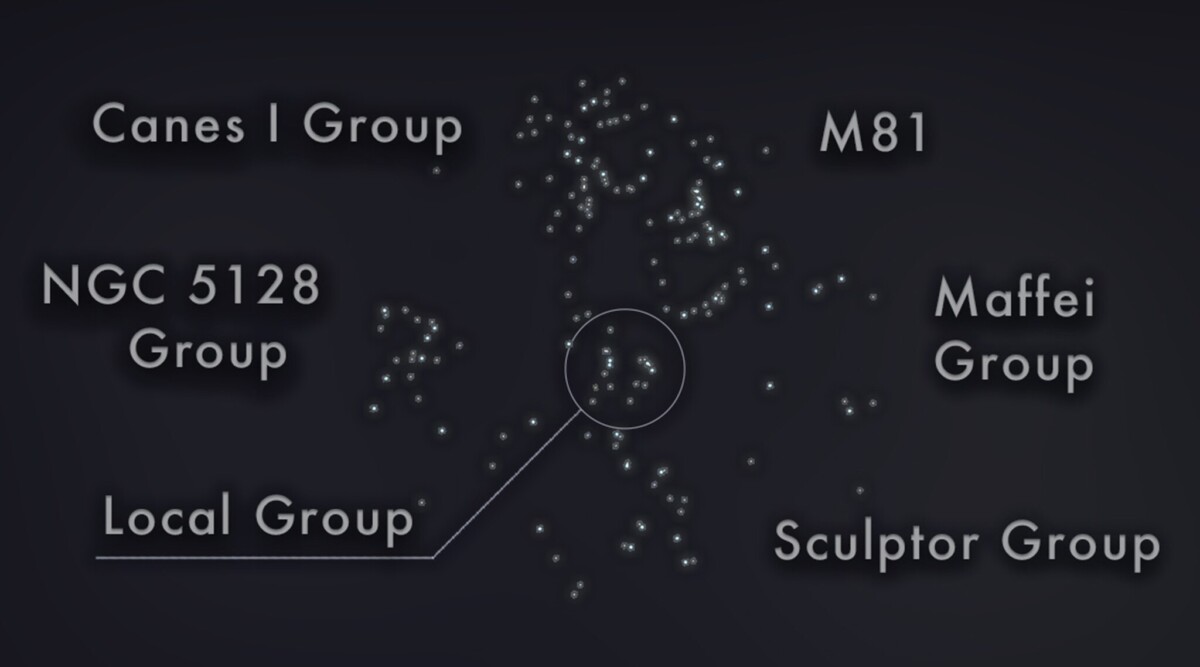
One last note about local gravity, our nearest galactic neighbor, Andromeda, is on a merger course with the Milky Way. This process, beginning in about 4.5 billion years, will not be a dramatic collision but a gradual merger, reshaping our galactic landscape over billions of years. Space is so sparse, our entire solar system is expected to be unaffected by the merger. While the Sun will still exist, it will be nearing the end of its life cycle, transitioning into a red giant. Observers on Earth, if it remains habitable, might note Andromeda’s increasing prominence in the sky, but the changes will unfold over such a vast timescale that they would not appear dramatic to any single generation.
Right now, based on our limited observations and knowledge, our best guess is that the universe ends in a Big Freeze. For this not to be true, we need more galactic material. Perhaps the needed mass is there, right in front of us, but we can’t see it yet, making it an unknown we will someday find. Or perhaps it’s there now but we are not capable of seeing it, making it an unknowable, which we can never hope to understand. For example, other dimensions might be there and ultimately unknowable to us. As for the potentially knowable unknown, we’re currently researching dark matter and dark energy and we really don’t fully understand them yet. There are also other possibilities too, some of which we can speculate about, but it’s also possible that we are just not smart enough to figure out a working model. For example, we have absolutely no idea what is beyond the CMB, nor the basic geometry of the universe. We’ll cover ideas about its geometry, flat or curved, after we explore the Big Rip and Big Crunch.
The Big Rip Idea
While the Lambda model is the leading and somewhat verified theory, the Big Rip is an alternate speculative idea. The premise of the Big Rip is that if the expansion of the universe, driven by dark energy, continues to accelerate without being checked. The power of dark energy expands the universe at a rate that dismantles all structures. This catastrophic process unfolds in stages. Trillions of years from now, but earlier in this cycle, the gravity of our Local Group of 54 galaxies is pulled apart, sending each galaxy on a voyage of its own. Much later, the stars of each galaxy are pulled apart, sending these solar systems, if you will, on their own journey. Much later still, the Big Rip overcomes the gravity binding solar systems and all planets and moons are sent on their own journey too. This continues by ripping apart the planets and stars into their materials and elements. It all culminates in a scenario where even the strong nuclear force, which binds atomic nuclei together, is overwhelmed. This final stage signifies the disintegration of atoms into their constituent particles, resulting in a universe filled with only diffuse, unbound particles.
The Big Rip is only speculative because there is little to no observations that support it, but it’s still discussed because we also have no observations yet that rule it out. It hinges on a form of dark energy that grows stronger over time. Something we don’t see yet. To clarify, the leading Lambda model uses math with a state-of-the-universe parameter (w) that describes the relationship between dark energy’s pressure and density. The Lambda model assumes the dark energy has a constant equation of state parameter (w) close to -1, which is tentatively supported by current observations. The Big Rip needs this value to be less than -1. Current observations align more closely with a cosmological constant (Λ), a form of dark energy with constant density. This suggests a universe that expands indefinitely but at a pace that allows gravitationally bound systems to remain intact.
The Lambda model provides a good fit for a wide range of observations and fewer assumptions, adhering to the principle of Occam’s Razor, where simpler theories are generally preferred over more complex ones. For the Big Rip to take the lead, it needs more compelling and better evidence to the contrary.
The Big Crunch Idea
Before we discovered the expansion of the universe was accelerating, the Big Crunch was the leading theory. The Big Crunch, while intriguing, is not supported by the bulk of current observations. It posits a closed universe scenario where the expansion of the universe eventually reverses, leading all matter and energy to reconverge into a singular state. This speculative event unfolds as the gravitational pull of all the matter in the universe eventually halts the expansion driven by dark energy, causing a cosmic collapse. In this collapse, galaxies, stars, and eventually the very fabric of space-time contract towards a final singularity, a mirror reversal of the Big Bang. The Big Crunch would be the final act in the life cycle of a closed universe.
The Big Crunch remains speculative for several reasons. First, there is little observational evidence to suggest that the universe is closed; measurements of the cosmic microwave background radiation, galaxy distributions, and supernovae all support a flat universe that will expand forever. Second, the theory relies on a future change in the behavior of dark energy, which current models do not predict. While the Big Crunch is not ruled out, it is a less likely than both the Lambda and Big Rip ideas.
The Flat Universe Idea
The Lambda model predicts a flat universe, but it is not yet confirmed. When cosmologists say that the universe is “flat,” they are referring to its large-scale geometry. The term “flat” is used to describe the spatial geometry of the universe as it relates to General Relativity and the curvature of space-time. This flatness is one of the possible shapes a universe can take according to the theory of General Relativity, and it depends on the universe’s density of mass and energy.
The foundation for relativity is the Relativity Principle, which states that the laws of physics are the same for everyone, regardless of how they’re moving. Special Relativity, born in 1905, explains how space, time, mass, and energy are interconnected. It showed that as objects approach the speed of light, time slows down, lengths contract, and mass increases. Finally, General Relativity, introduced in 1915, explains gravity not as a force, but as a warping of spacetime caused by massive objects. This warping tells us how objects move in the universe.
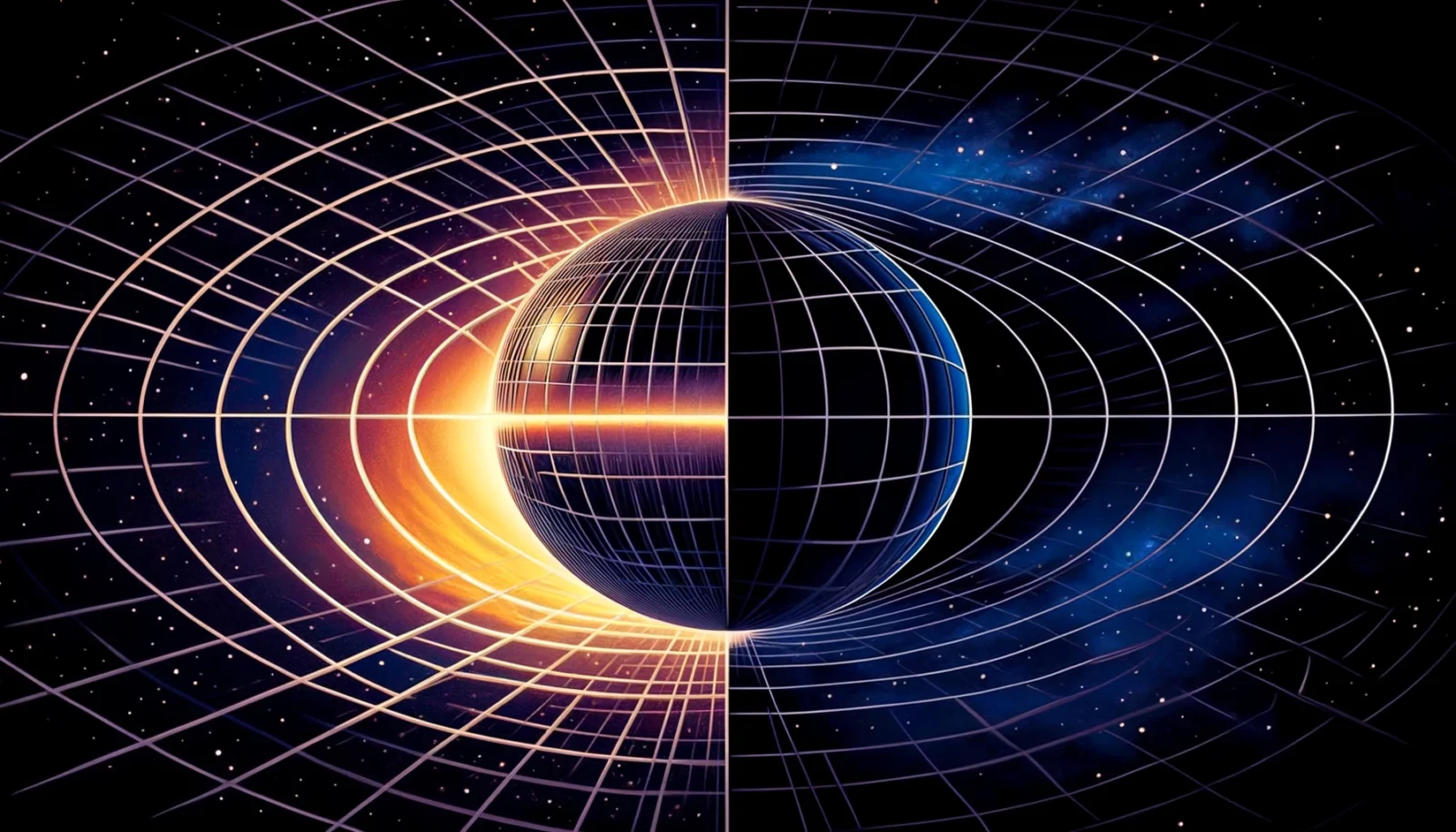
In a flat universe, the rules of Euclidean geometry that we are familiar with from everyday life apply on the largest scales: parallel lines never meet, the angles in a triangle add up to 180 degrees, and the universe does not curve back on itself. If you read my The Expanding Universe Explained article, the analogy of the expanding universe to an expanding balloon needs serious updating. While the expanding balloon analogy helps us imagine an expanding universe, its spherical implications need serious updating under a flat universe. The expanding balloon idea implies that space is curved and if we travel in one direction long enough, we come back to the same spot, but that’s the closed universe model.
The concept of flatness in cosmology is intimately connected to the fate of the universe and the critical density, which is the density required to halt the expansion of the universe. Measurements of the cosmic microwave background radiation, particularly those from the WMAP and Planck space missions, have indicated that our universe is flat with only a 0.4% margin of error. This suggests that the universe is very close to the critical density, which has profound implications for cosmology and our understanding of the universe’s ultimate fate.
However, there remains two other possibilities:
Closed Universe: If the universe has a density higher than a critical value, space-time is positively curved, much like the surface of a sphere. This implies that parallel lines would converge and the angles of a triangle would add up to more than 180 degrees. This also means that if you travel far enough in a straight line, you could theoretically end up back where you started. In the balloon analogy, if you travel in one direction long enough, you’ll end up back where you started.
Open Universe: If the density is lower than the critical value, the universe is negatively curved like a saddle. This implies that parallel lines would diverge and the angles of a triangle would add up to less than 180 degrees.
Returning to the critical density idea. It is pivotal in cosmology as it represents the precise balance between the gravitational force pulling matter together and the expansion of the universe driving it apart. If the universe’s density is exactly at this critical point, it means that the gravitational pull is perfectly balanced with the force of expansion, leading to a flat universe. This is represented by the w=-1 idea. It suggests that the expansive force of the universe is neither strong enough to cause indefinite expansion (as in an open universe) nor weak enough to result in a gravitational collapse (as in a closed universe). Instead, the universe expands at a rate that is balanced over large scales, consistent with the properties of Euclidean geometry.
Assuming the universe is flat, the idea of what’s beyond the CMB becomes critical to understanding the ultimate fate of the universe.
The Islands-of-Universes Idea
Let’s conclude this article with some truly on-the-edge speculation and a bit of philosophy. First, a speculative journey beyond the observable cosmos. The reason we currently believe the Big Freeze is that we don’t see enough galactic material to prevent it. What if that galactic material is outside the CMB? What if there are other “islands-of-universes” out there that can introduce more galactic material to our universe? Wouldn’t that negate the Big Freeze prediction? Yes, it would. I think. I guess it might depend on how far away the other “universes” are. Yes, more speculation, but this speculation is less depressing, and here’s the kicker, right now, with what little we know, it’s possible.
So, regarding the Big Bang, I have a very speculative idea. Is it possible that Big Bang-like singularities happen throughout a much bigger-than-known universe? Imagine the universe outside the CMB being trillions of times larger with galactic material, and what we might call islands-of-universes scattered throughout. Now think about the known idea that when a bunch of material gets gravitationally close, it becomes a black hole. What if the collision of enough black holes and other material causes what we currently call a singularity What if what we currently call our 93 billion light-year wide universe is simply some of an unknown amount of galactic material in a much bigger “universe” than what we can see? This would mean that various beings within such a singularity might share our journey of discovery leading to a discovery of universes. The path would begin by discovering there star is but one of many stars. Then there galaxy is but one of many galaxies. At that point, they have the technology to see the CMB, the outer edge of their singularity, but eventually see past it and recognize their singularity is but one of many.
In exploring the grand tapestry of the cosmos, understanding the universe’s geometry—whether open, closed, or flat—becomes crucial. The curvature of the universe dictates not only its ultimate fate but also the nature of its expanses beyond our current observational reach. A flat universe, as suggested by the latest cosmological data, implies an infinite expanse, not curved back upon itself like the surface of a balloon, but extending endlessly in all directions.
In such a flat, potentially infinite universe, the door opens to fascinating possibilities beyond the observable horizon. One speculative idea worth considering in this context is the “Islands-of-Universes”. This concept imagines that beyond the cosmic microwave background (CMB) that marks the boundary of our observable universe, lies a vast, perhaps boundless, cosmic ocean dotted with island universes—each a realm unto itself, possibly with its own laws of physics, born from singularities not unlike our own Big Bang.
This thought experiment posits a universe far grander than the expanse currently encapsulated by the cosmic microwave background (CMB) — our universe’s oldest light, revealing a cosmos 93 billion light-years wide yet potentially just a speck within an incomprehensibly larger cosmic ocean.
While the “Islands-of-Universes” says nothing about other dimensions or parallel universes, it does imagine a cosmos where Big Bang-like singularities sporadically occur. These cataclysmic events birthing entire universes — throughout a vastly larger universe. Each akin to an island and scattered across the great ocean of space-time. This grander universe, trillions of times more expansive than our observable domain, houses galactic materials and phenomena on scales unfathomable, where what we perceive as the entirety of our universe might merely be a localized cluster within this colossal expanse.
Relation to and Divergence from Existing Theories
While echoing themes from multiverse theories and notions of black hole-generated universes, the “Islands-of-Universes” Hypothesis ventures into uncharted territory. Unlike multiverse theories that often emerge from the mathematics of inflationary cosmology — suggesting multiple, causally disconnected “bubble universes” — this idea speculates on the physical, observable consequences of universes within universes, interconnected through the fabric of a much grander cosmos. It diverges from the idea of a Big Freeze as an ultimate fate, suggesting instead a cosmic landscape where singularities and the birth of new universes are recurring phenomena.
The hypothesis invites us to envision a universe where the boundaries of our cosmic island are not the final frontier but rather gateways into a broader cosmic saga. It suggests that beings within such a universe, upon reaching the limits of their observable domain and piercing the veil of the CMB, might discover not the edge of all there is but rather the shores of their own cosmic island, one of many in a vast cosmic archipelago — a super local cluster if you will.
While firmly speculative, the Islands-of-Universes idea aligns intriguingly with a flat universe model. In a cosmos without curvature limiting its expanse, the potential for such island universes becomes an enticing avenue for theoretical exploration. It invites us to ponder the true scale of reality and the possibility that our universe, vast and magnificent as it is, might be just one of countless others scattered across an even grander cosmic canvas.
Time, A Philosophical Ponderance
Let me conclude with a philosophical challenge to rethink our place within the infinite expanse. Just a few hundred years ago, we had no idea about the microscopic world, nor that our Sun was but one star among many, let alone galaxies, local clusters of galaxies, and the immense expanse of the currently known universe.
Tardigrades, creatures of the newfound microscopic realm, were first observed in 1773. They can survive the cold vacuum of space and a few dozen degrees hotter than the hottest places on Earth. Yet these remarkable creatures have no idea that larger life exists, let alone the empirical observations of humanity. What if humanity, like tardigrades unaware of the broader universe, is only beginning to glimpse the vast complexities of a cosmos far beyond our current understanding?


